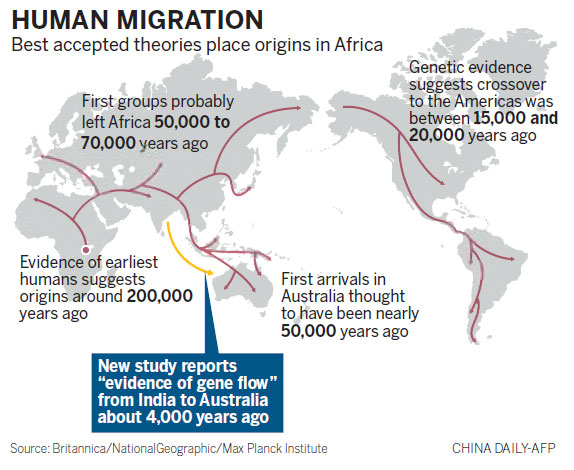Indians broke Australian isolation 4,000 yrs ago
Updated: 2013-01-16 09:37
(China Daily/Agencies)
|
||||||||
Research finds they brought dingo's ancestors with them
Ancient Indians migrated to Australia and mixed with Aborigines 4,000 years ago, bringing the dingo's ancestor with them, according to new research that re-evaluates the continent's long isolation before European settlement.
Australia was thought to have been cut off from other populations until Europeans landed at the end of the 1700s, but the latest genetic and archaeological evidence throws that theory out.
 |
Researchers at the Max Planck Institute for Evolutionary Anthropology in Leipzig, Germany, reported "evidence of substantial gene flow between Indian populations and Australia about 4,000 years ago".
They analyzed genetic variations across the genome from Australian Aborigines to New Guineans, Southeast Asians and Indians, including Dravidian speakers from the south.
"The prevailing view is that until the arrival of Europeans late in the 18th century, there was little, if any, contact between Australia and the rest of the world," the study released on Tuesday noted.
However, analysis of genomewide data gave a "significant signature of gene flow from India to Australia which we date to about 4,230 years ago", or 141 generations back.
"Long before Europeans settled in Australia, humans had migrated from the Indian subcontinent to Australia and mixed with Australian Aborigines," the study said.
"Interestingly," said lead researcher Irina Pugach, "this date also coincides with many changes in the archaeological record of Australia, which include a sudden change in plant processing and stone tool technologies and the first appearance of the dingo in the fossil record."
The study explained that although dingo DNA appears to have a Southeast Asian origin, "morphologically, the dingo most closely resembles Indian dogs.
"The fact that we detect a substantial inflow of genes from India to Australia at about this time does suggest that all of these changes in Australia may be related to this migration."
The predatory wild dingo (Canis dingo) has grown into something of an Australian legend alongside kangaroos, but is often treated as a pest attacking sheep and cattle.
They roam the outback, hunting alone or in packs, communicate with wolflike howls and scavenge from humans.
The term is believed to have been picked up by early settlers from a similar sounding Aboriginal word for a tame dog.
A common origin was also discovered for the Australian, New Guinean and Philippine Mamanwa populations, who followed a southern migration route out of Africa beginning more than 40,000 years ago.
The researchers estimate the groups split about 36,000 years ago when Australia and New Guinea formed one land mass.
"Outside Africa, Aboriginial Australians are the oldest continuous population in the world," said Pugach, a molecular anthropologist.
Australia offers some of the earliest archaeological evidence for the presence of humans outside Africa, with sites dated to at least 45,000 years ago.
Agence France-Presse

 Li Na on Time cover, makes influential 100 list
Li Na on Time cover, makes influential 100 list
 FBI releases photos of 2 Boston bombings suspects
FBI releases photos of 2 Boston bombings suspects
 World's wackiest hairstyles
World's wackiest hairstyles
 Sandstorms strike Northwest China
Sandstorms strike Northwest China
 Never-seen photos of Madonna on display
Never-seen photos of Madonna on display
 H7N9 outbreak linked to waterfowl migration
H7N9 outbreak linked to waterfowl migration
 Dozens feared dead in Texas plant blast
Dozens feared dead in Texas plant blast
 Venezuelan court rules out manual votes counting
Venezuelan court rules out manual votes counting
Most Viewed
Editor's Picks

|

|

|

|

|

|
Today's Top News
Boston bombing suspect reported cornered on boat
7.0-magnitude quake hits Sichuan
Cross-talk artist helps to spread the word
'Green' awareness levels drop in Beijing
Palace Museum spruces up
First couple on Time's list of most influential
H7N9 flu transmission studied
Trading channels 'need to broaden'
US Weekly

|

|







